Primo Quality
Please see below for what Primo Azabujuban Clinic does before and after surgery to ensure safety and better results.
Our doctors, nurses, and cosmetic counselors work hard every day to provide better medical services.
INDEX
Before Surgery
During Surgery
- Pictures of your ideal look.
- Our various types of beds
- Measures to prevent bedsores
- About Foot Pumps
- Intra-operative warming
- Thorough protection of the eyes
- We do a thourough count of the needles used in surgery.
- The drip needle
- About Anesthesia
- Pain relief measures
- Thorough infection control measures
- Intra-operative cleaning to prevent post-operative infection
- Use of suction drain equipment
- Smoke evacuation systems presemt in all operating rooms
Before Surgery
A detailed pre-operative pamphlet is provided to explain the procedures.
All of our patients are given a pamphlet that contains information about post-operative precautions, details about the procedure, and the day of surgery and the stages, so they can feel completely confortable on surgery day.

We have many post-operative progress photos.
There are many photos of post-operative results, and in many cases you can see the results and progress of the surgery you are about to undergo, making it easy to understand and visualize the post-operative condition and changes.
Preparation for the day before surgery
The day before surgery, our staff will call you to confirm everything.
We work hard to make patients feel confortable and hilight the importance of visit times, fasting, and fasting times.

Thorough pre-operative interview
Blood tests such as blood count, liver function, kidney function, hemostasis coagulation, and infectious disease testing are all performed prior to surgery.
If you are scheduled for general anesthesia, in addition to blood tests, an EKG and chest radiographs will be taken.
In the case of surgery involving osteotomy, a pre-operative CT is taken.
In addition, detailed interviews are set up with the nurse on the initial visit, before each examination, and on the day of surgery.
Our priority is safety and security, and so we make sure that surgery is only scheduled after repeated checks to ensure the patient’s good health.
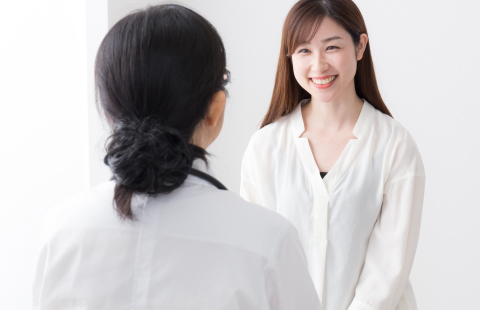
Thorough care of patients’ valuables
Lockers for valuables are available in the post-operative recovery room, each treatment room and the operating room.
We take complete care of valuables during and after the operation.
Large luggage from abroad can be kept in the cloakroom.
Please feel free to visit us for a consultation anytime.
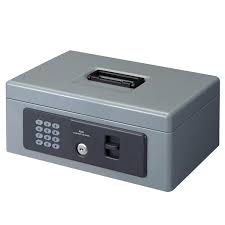
Protection of privacy
We have four private waiting rooms.
We have three completely private recovery rooms where you can take a rest after the surgery on same day.
We make sure that you avoid other pateint during your stay and so, protect your pivacy.
We have full-time staff who are qualified to protect all of your personal information such as medical records and photos.
We have introduced a total security management service system from NTT PC communications to prevent unauthorized access via the Internet.
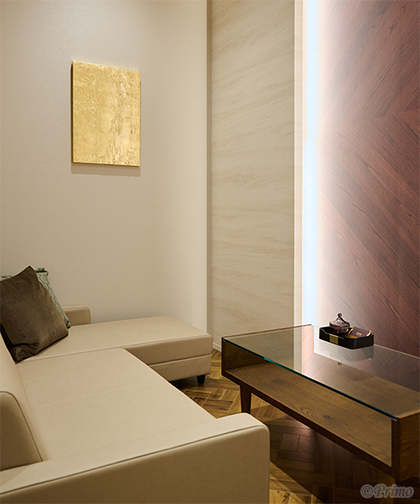
Photo Room
Our clinic is equipped with two photo rooms for taking pre- and post-operative photos.
This allows us to compare pre- and post-operative photos taken under the same conditions.
Our photo rooms were designed by a specialist, and a professional photographer set up the shooting conditions.

X-ray/CT Room
We perform chest x-rays before general anesthesia.
We use the X’sy Pro diagnostic X-ray system manufactured by SHIMADZU and the AeroDR diagnostic imaging system manufactured by KONIKA MINOLTA.
The CT imaging system is a KaVo OP 3D Vision.
These help with accurate pre-operative diagnosis, selection of treatment strategy, and creation of custom-made prostheses, as well as ensuring medical safety.
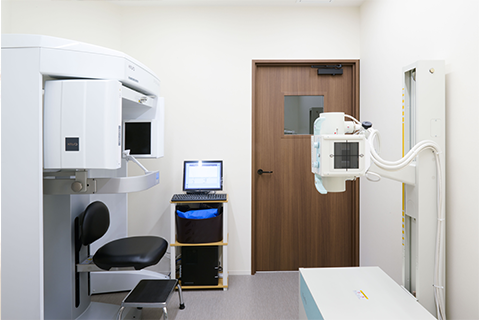
During Surgery
Pictures of your ideal look.
During surgery, pictures of the patient and the patient’s ideal images will be displayed in the operating room.
During surgery, we will get as close as possible to our patients’ ideals by constantly reviewing the photographs.
The simulated images created during the patient’s consultation before surgery are also placed in the operating room.
If there happens to be a picture that you are unsatisfied with, we will note it as NG, and we will rectify surgery in accordance with this change.

Our various types of beds
The surgical beds in our clinic can raise the upper body automatically.
This allows you to both sit with your upper body in a seated position, and lean back to check the design and results of your surgery.
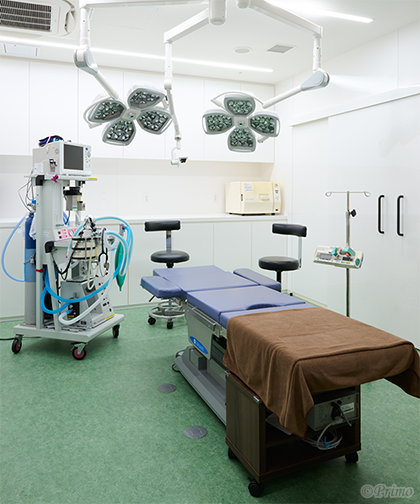

This is very useful for breast augmentation size checks and eye surgery.
The beds in our recovery room, where you can rest after surgery, are also the type that can raise your upper body automatically.
This bed allows you to breathe easily after surgery without any abdominal pressure.
It is also effective in reducing post-operative edema.
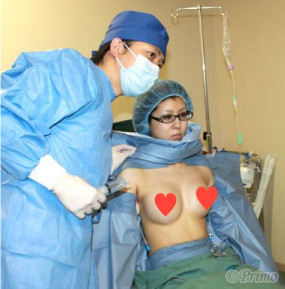
The bed in the private room used for cosmetic dermatology treatment can also have the angle adjusted in the same way, so you can feel comfortable in a sitting position during treatment.
You can relax while you wait for your consultation or treatment.
Measures to prevent bedsores
Surgery will be painless under general or intravenous anesthesia, and the patient will be in a state of sleep.
While lying down, some of our body parts experience pressure.
If lying down for a long time, sometimes poor circulation can results in a bedsore.
To prevent bed sores during surgery, our nurses regularly move the patient’s body and use decompression bags.

About Foot Pumps
As the duration of general anesthesia increases, the risk of complications goes up.
One complication is pulmonary embolism caused by deep vein thrombosis (DVT).
You’re probably familiar with the term “economy class syndrome”.
While the patient is under anesthesia, the patient has no body movement which reduces blood circulation and makes it easier for blood clots to form.
Pulmonary embolism is a blockage of blood vessels in the lungs that can lead to death in some cases.
We use an air compression technique with a foot pump to prevent pulmonary embolism.
Repetitive pressure on the calf and plantar area helps prevent DVT and pulmonary embolism by maintaining venous blood flow from the plantar area.

Intra-operative warming
During surgery, the effects of the anesthetic, the position of the body, and exposure and disinfection of the skin at the surgical site may cause a drop in body temperature.
If your body temperature is low during surgery, you may experience chills or pain when you wake up.
Low body temperature has also been shown to increase complications such as arrhythmia.
In our clinic, we minimize skin exposure during surgery and heat non-exposed areas with electric blankets to prevent a drop in body temperature.
If necessary, we will warm up the drip during anesthesia management and then infuse it into the bloodstream.
The tumescent solution used in liposuction surgery is also warmed for the same reason.
For patients who feel cold after surgery, we provide electric blankets and adjust the room temperature in the recovery room for their comfort.
Thorough protection of the eyes
During general or intravenous anesthesia, you cannot blink and your eyes tend to become dry.
Also, under anesthesia, you won’t know if your eye is compressed during surgery, and so serious complications can occur.
We ensure that the eye is always protected during surgery.
The anesthesiologists and nurses regularly check the eye area during surgery.

Eye drops are given for pain relief before surgery.
Sometimes it difficult to close your eyes after surgery which can lead to dry eyes and occasionally conjunctivitis.
During surgery, we apply eye ointment to prevent dry eyes and we also apply eye protection sheets.
For eye enlargement surgery, we prescribe eye drops and eye ointment as well as tape to keep the eyelids closed during sleep.
We will also prescribe you this medicine for a further few days or weeks.
With the conjunctival approach, we use a powerful analgesic and anti-inflammatory eye drops to prevent Swelling and anti-inflammation.
We do a thourough count of the needles used in surgery.
The nurses are responsible for counting the number of needles and threads before and after each surgery to ensure that nothing is left behind.
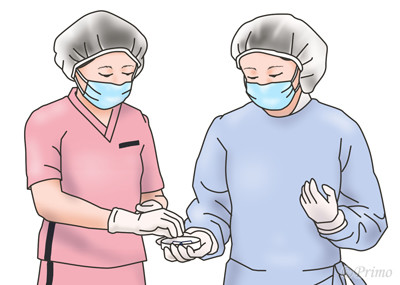
The drip needle
We mainly use 22G indwelling needles in surgery at our clinic.
Appropriate needle thickness is selected according to the concentration of the drug to be administered, the dose, and the length of surgery, and a slightly thinner needle is used to reduce any pain.
For patients sensitive to pain, an inhalation anesthetic is used to put them to sleep before placing the IV in them.
At the time of needle removal, we perform a long and reliable pressure hemostasis to prevent internal bleeding.

About Anesthesia
Pain is the common enemy of all patients, and our staff will strive to minimize pain during all treatments.
For general anesthesia, our anesthesiologists are from the Society of Anesthesiologists and approved by the Ministry of Health, Labour and Welfare (MHLW), and our expert nurses will support them.
Pain relief measures
We use nerve blocks and local anesthesia.
For those who have more time, we can also offer strong skin penetrating anesthetic creams and tapes.
Even for patients who are short on time, we always allow the area to cool sufficiently before performing injection treatment to minimize pain.

Thorough infection control measures
All of our surgical instruments and medical equipment are sterilized by autoclave after the first and second cleanings.
In the case of operating on patients with infectious diseases, we use single-use disposable instruments as much as possible and cover the surgical bed and equipment with plastic to prevent transmission.
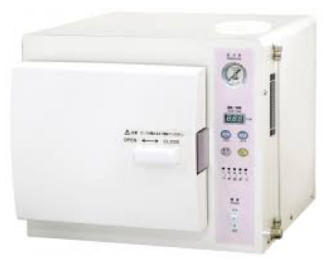
The ethylene oxide gas sterilization method, which has a sterilizing effect at low temperatures, is an excellent process for the safe and reliable sterilization of medical devices that are susceptible to high temperatures and cannot be sterilized by dry heat.
This ethylene oxide gas sterilizer has been in constant use since the opening of our clinic, and it has helped to drastically reduce the incidence of peri-operative infections.
In accordance with the law, our work space is periodically measured by a specialist and safety checks are performed.
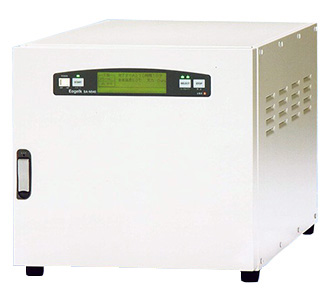
Intra-operative cleaning to prevent post-operative infection
In order to prevent post-operative infection, the operative field is rinsed thoroughly with saline before closing the wound in the case of highly invasive surgery.
A mixture of antibiotics and hemostatic agents are used to thoroughly clean the area to reduce the incidence of post-operative infection.
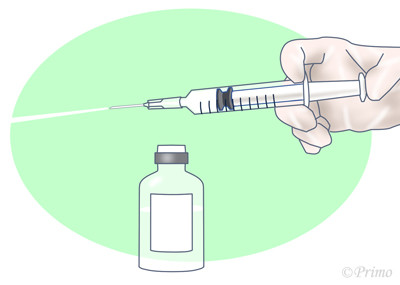
Use of suction drain equipment
During surgery, fluid and blood can accumulate as a result of operations such as dissection and incision of the surgical field.
During surgery, we perform a thorough hemostatic procedure to prevent seroma and hematoma.
In the unlikely event that seroma and hematoma build up, they can cause suture failure, infection, and prolonged swelling.
To prevent this, we also actively insert suction drains during surgeries where there is a small risk of this happening.
The suction drain device allows the body to expel the stored fluids and blood from the body, and the expelled fluids and wound are observed, which leads to the early detection of infection and promotes wound healing.
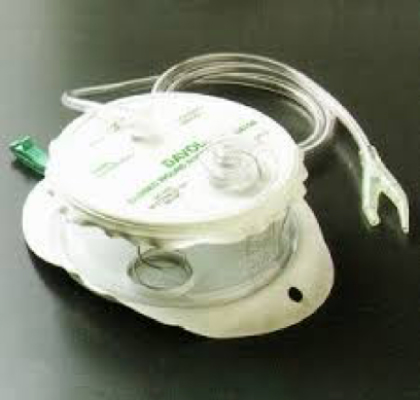
Smoke evacuation systems presemt in all operating rooms
Dissection and incision during surgery can cause leachate and blood to accumulate.
Hemostatic devices are used in surgery. Surgical smoke is generated when using these products.
Surgical smoke can contain more than 27 toxic substances, including hydrogen cyanide, formaldehyde, toluene, and carbon monoxide, as well as bacteria and viruses.
The risk of surgical smoke from a day of electrocautery use in the operating room is equivalent to smoking about 30 cigarettes of carbon monoxide.
Standard surgical masks cannot protect us against the minute toxic substances in surgical smoke. Health problems such as chronic obstructive pulmonary disease (COPD) and pneumonia have been reported in healthcare workers.
In the United States, 12 states will require the installation of smoke evacuation devices in operating rooms by the end of 2020, and nine more states will do so by 2021.
In Japan, a statement jointly issued by the Japanese Medical Science Federation and various surgical societies recommended ‘the use of smoke evacuation devices when using electrocautery’.
Smoke evacuation devices remove surgical smoke and reduce the risk of health hazards to patients, nurses, anesthesiologists, and surgeons.
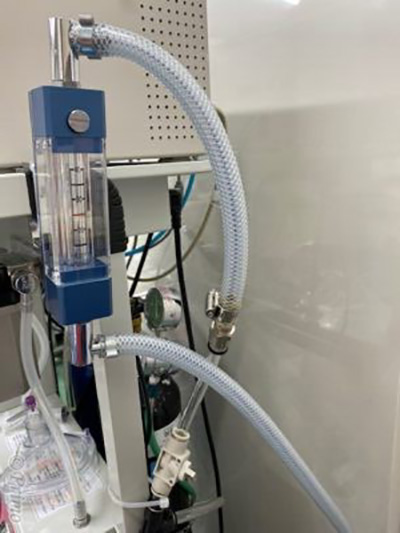
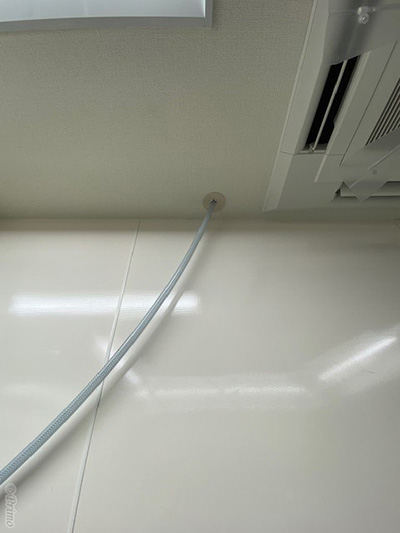
After Surgery
Post-operative antibiotics
One of the complications that can occur after surgery is post-operative infection.
Post-operative infection is when the surgical site becomes contaminated and bacteria enter and cause an infection.
Bacteria are not only found in the human nasal cavity, oral cavity, ear canals and skin surfaces, but also in the air of the room.
It is not an exaggeration to say that bacteria are always present in and around the area where surgery is performed.
We thoroughly disinfect during the operation and always prescribe antibiotics after the operation.
For patients with suction drain devices or for procedures with a relatively high risk of post-operative infection, such as the insertion of a foreign object (e.g., a prosthesis), we offer free-of-charge antibiotics administered intravenously for about two days after surgery in addition to oral medication.

Relief of swelling, internal bleeding and other symptoms after surgery
We offer radiofrequency hyperthermia (CET) to reduce subcutaneous bleeding, swelling and edema of the wound after surgery.
Radiofrequency hyperthermia raises blood flow deep in the wound by radiofrequency and improves blood circulation to reduce swelling and edema and eliminate internal bleeding at an early stage.
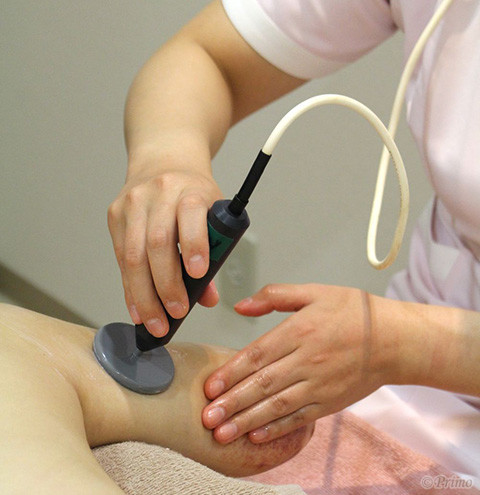
We prescribe herbal remedies and Sinecch for early reduction of post-operative edema.
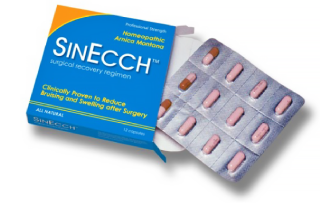
To protect wounds, we provide post-operative care with micropore tape, kelo-cote, and wound creams to help wounds settle nicely and quickly.
For internal bleeding, we have a medical concealer that can be used directly on the wound to cover the subcutaneous bleeding spots.
Recovery and going home immediately after surgery
After surgery, all post-anesthesia recovery management will be done in a private recovery room.
Your nurse will check your vital signs (blood pressure, oxygen saturation, pulse, etc.) regularly.
At 1 to1.5 hours after surgery, the patient will be examined and allowed to drink water after healthy bowel confirmation, and then the drip will be removed.
After further confirmation of recovery, sweet snacks will be offered, such as juice, chocolate and cookies.
Your doctor will examine you and confirm that you have made a satisfactory recovery, and then you will be allowed to go home. Please let us know if you need a taxi.
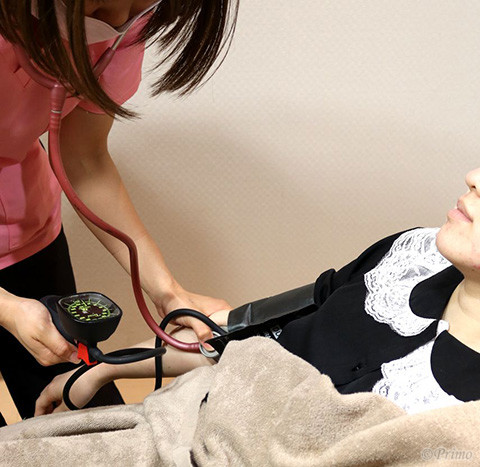
About the recovery room
We have three completely private recovery rooms where you can rest after surgery.
After general and intravenous anesthesia, respiratory status and circulatory dynamics will be observed, and blood pressure, oxygen saturation, and pulse rate will be continuously measured.
We also check vital signs and observe for pain to detect abnormalities early and minimize pain.
If necessary, intravenous medication, oxygenation and nebulizer treatment will be administered in the recovery room.
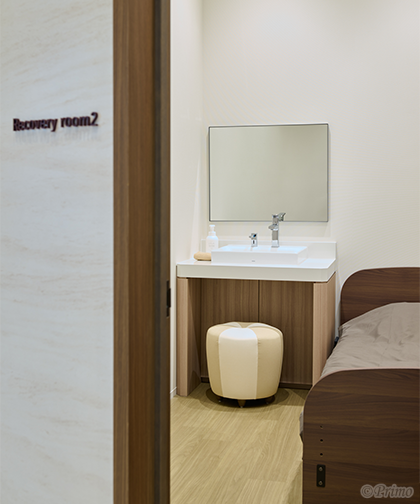
About WCs
Three restrooms are present, one of which is wheelchair accessible.
Handrails and IV hooks are provided for post-operative patients.
We also have an ostomate should any patient require one.
Please do not hesitate to contact us if you have any questions.These help with accurate pre-operative diagnosis, selection of treatment strategy, and creation of custom-made prostheses, as well as ensuring medical safety.
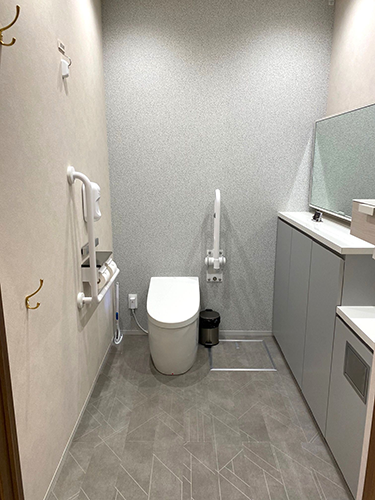
Post-operative infection compensation plan
Post-operative wound infections are one of the most common causes of poor post-operative outcomes.
We have thorough infection control measures in place, and while the incidence of post-operative infections is minimal, it is impossible to reduce the number to zero.
In order to help the patient in the event of such an infection, we have a post-operative infection compensation plan in place.
In the event of an early post-operative infection at the surgical site, we will compensate you for the cost of IV antibiotics for initial treatment, oral antibiotics, surgery to remove any foreign body to calm the infection, and the cost of initial revision surgery (including the cost of anesthesia) 3-6 months after sugery.
